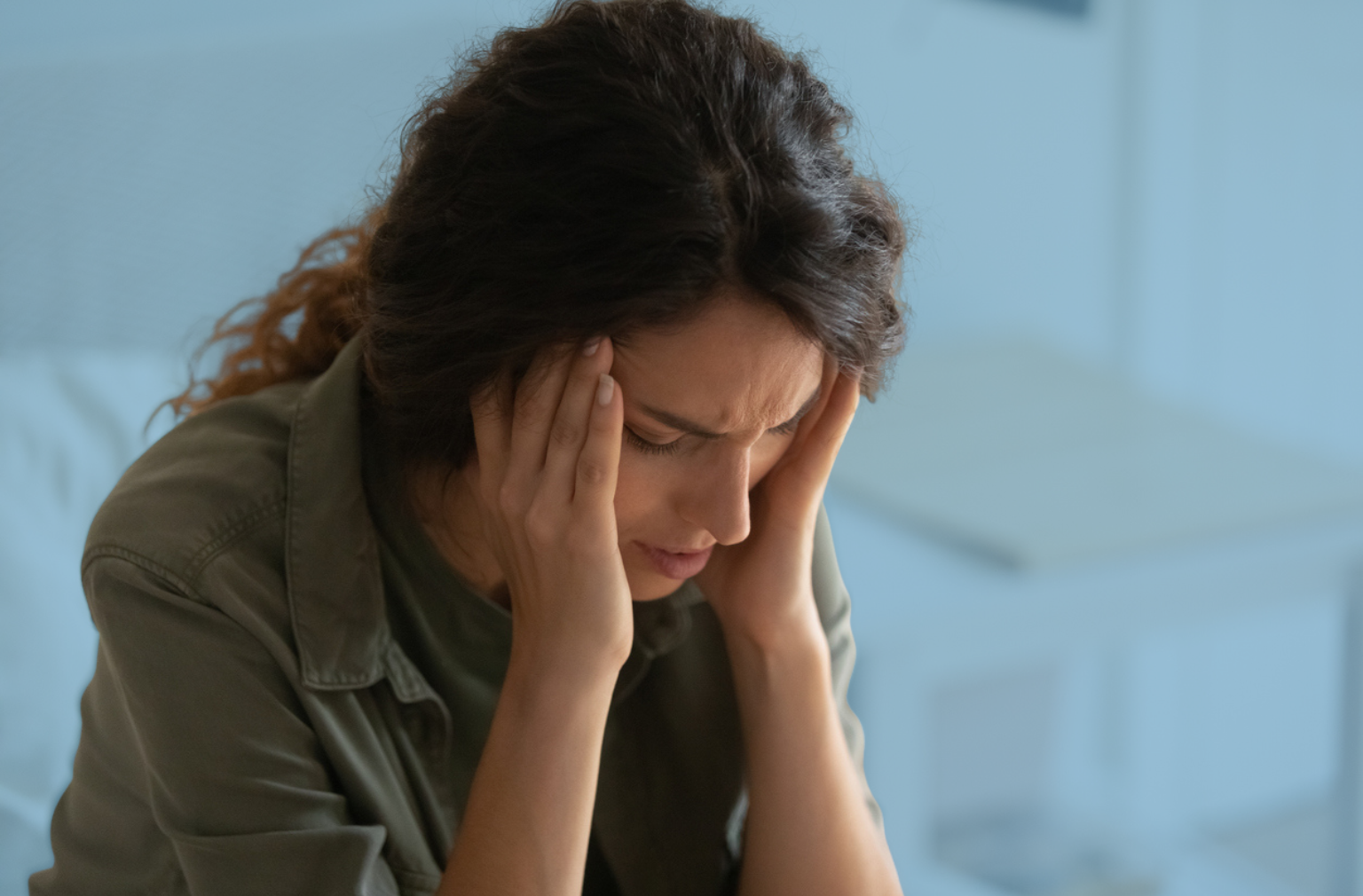Menopause Migraines: Your Path from Pain to Relief
Evidence-based migraine relief designed for menopausal women, featuring hormone tracking, natural stabilisation, and targeted nutrition.

Migraines often become more frequent, intense, or unpredictable during perimenopause, and it’s not just in your head. Research shows that migraine affects women three times more often than it does men (Ornello et al., 2021), and the hormonal fluctuations of the menopausal transition create a perfect storm for increased migraine activity.
This isn’t simply about getting older, it’s a specific biological challenge requiring targeted intervention strategies.
The Estrogen-Migraine Connection
Research shows that when estrogen drops suddenly (like right before your period), it can trigger migraine attacks (Sacco et al., 2012). During perimenopause, these hormone dips happen more often and at unpredictable times.
Beyond estrogen, progesterone, a naturally calming hormone, also declines during perimenopause. This hormone protects your brain from migraine triggers by reducing inflammation and nerve sensitivity (Godley et al., 2024). When progesterone levels fall, you lose an important natural defence against headaches.
Why Perimenopause Makes Migraines Worse
During perimenopause, some women may notice that they have more frequent attacks. The attacks may be more burdensome, harder to get rid of, and women may have to be more aggressive with their acute therapy. Additionally, many women progress from episodic to chronic migraine during this phase (Martin et al., 2016).
The perimenopausal period brings:
- Erratic estrogen and progesterone fluctuations exceeding normal menstrual cycle variations
- Sleep disruption from night sweats and anxiety
- Increased stress from life changes and physical symptoms
Tracking Your Migraine Patterns
Essential components:
- Sleep quality
- Attack frequency, duration, and intensity
- Associated symptoms and treatment response
- Stress levels and lifestyle triggers
Perimenopausal patterns to watch:
- Pure menstrual migraine: Attacks in the late luteal phase, affecting around 7% of perimenopausal women with migraines (Martin et al., 2016)
- Menstrual-related migraine: Attacks around menstruation and at other cycle times
- New-onset migraines: First-time migraines triggered by hormonal changes
Evidence-Based Prevention Strategies
Hormonal Stabilisation
Natural remedies can help stabilise fluctuating hormones during perimenopause, providing relief for hormonally-triggered migraines. Support hormone balance with:
- Phytoestrogens (soy isoflavones, flaxseeds, black cohosh, red clover)
- Liver detoxification (cruciferous vegetables, B-vitamins, adequate fibre)
- Progesterone production (vitamin B6, magnesium, zinc)
Targeted Nutritional Support
Magnesium supplementation can help stabilise hormonal fluctuations and reduce migraine frequency during perimenopause, particularly beneficial when cycles become irregular or unpredictable (MacGregor, 2017)
Additional migraine-protective nutrients:
- Riboflavin (vitamin B2): Daily for prevention
- Coenzyme Q10: Supports cellular energy production
- Omega-3 fatty acids: Anti-inflammatory support
- Vitamin D: Hormonal and immune system support
Sleep Prioritisation
Maintaining consistent sleep-wake schedules despite night sweats, creating cool and dark sleeping environments, and incorporating stress management techniques and mindfulness practices can significantly improve sleep quality during perimenopause
Creating Your Prevention Plan
Given the high prevalence of migraine, the increased incidence of attacks associated with menstruation and the worsening of migraine associated with the transition to menopause, perimenopausal women should be routinely asked about migraine and should receive appropriate specialised counselling (Ornello et al., 2021).
Your plan should include:
- Comprehensive migraine and hormonal history assessment
- Appropriate testing for hormone levels and nutritional status
- Individualised treatment addressing both acute and preventive needs
- Regular monitoring as hormone patterns evolve
While perimenopause can temporarily worsen migraines, there’s hope ahead. Population-based studies have shown an improvement of migraine after menopause, with a possible increase in perimenopause (Ripa et al., 2015).
Conclusion
The intersection of menopause and migraines creates unique challenges, but understanding the hormonal mechanisms empowers women to take targeted action. The dramatic estrogen fluctuations of perimenopause, combined with declining progesterone, create a complex but manageable situation.
With proper tracking, individualised treatment approaches, and patience during the transition, maintaining quality of life despite hormonal migraines is entirely achievable.
How Emsee Can Help
Navigating the complex relationship between menopause and migraines requires specialised expertise that understands both hormonal health and comprehensive migraine management.
Book a free first consultation with one of our experienced doctors, naturopaths or nutritionists today by calling 1300 412 422 or fill out our online contact form.
Alternatively, answer a few questions about your health and lifestyle to get a free assessment report on your situation and discover if Emsee is the perfect match for you.
References
- Martin, V.T., Pavlovic, J., Fanning, K.M., Buse, D.C., Reed, M.L., & Lipton, R.B. (2016). Perimenopause and menopause are associated with high frequency headache in women with migraine: Results of the American Migraine Prevalence and Prevention Study. Headache, 56(2), 292-305.
- Ornello, R., Caponnetto, V., Frattale, I., & Sacco, S. (2021). Patterns of migraine in postmenopausal women: A systematic review. Neuropsychiatric Disease and Treatment, 17, 859-871.
- MacGregor, A. (2017). Migraine, menopause and hormone replacement therapy. Post Reproductive Health, 23(1), 11-18.
- Ripa, P., Ornello, R., Degan, D., Tiseo, C., Stewart, J., Pistoia, F., Carolei, A., & Sacco, S. (2015). Migraine in menopausal women: A systematic review. International Journal of Women’s Health, 7, 773-782.
- Sacco, S., Ricci, S., Degan, D., & Carolei, A. (2012). Migraine in women: The role of hormones and their impact on vascular diseases. The Journal of Headache and Pain, 13(3), 177-189.
This article is intended for informational purposes only and does not replace professional medical advice. Please consult with a healthcare provider for any specific symptoms or issues you might be experiencing.











